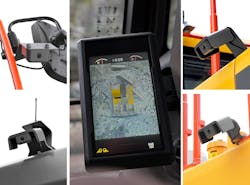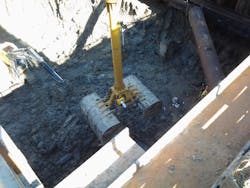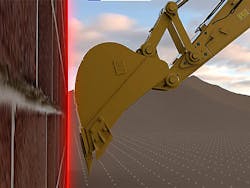In 2020, the U.S. Bureau of Labor Statistics recorded 1,034 fatal injuries and 74,520 nonfatal injuries among all construction workers. Most of the fatal injuries and a large proportion of the nonfatal injuries resulted from what the Occupational Safety and Health Administration (OSHA) calls the construction Focus Four hazards: falls, struck-by (backing equipment, shifting materials, workers on foot/poor worker position), electrocutions (powerline contact), and caught in/between (rotating equipment with blind spot, trench/excavation, material handling).
A 28-year-old laborer was killed in a struck-by accident while working as a flagger on an asphalt resurfacing job. He was standing with his back to a tack truck as it was backing up. The driver thought he had run over a manhole cover and kept going. Seeing a nearby dump truck driver running and waving his arms in his mirror, the tack truck driver stopped. Both drivers found the victim lying face down on a manhole cover on the ground.
A worker was injured in a caught-between accident when a crane operator in New Jersey was moving rolls of coiled steel. The coils were stacked three high and weighed 10,000-pounds each. When the operator lifted the top coil, the movement somehow dislodged a neighboring coil, causing it to slip forward off the row, pinning the co-worker against a row of coils behind him.
Although OSHA regulations specify audio alarms on heavy equipment, the nature of construction makes it difficult to hear those alarms over the din of the job site. If workers are wearing hearing protection or music buds, it may become impossible. Visual tools such as onboard cameras can identify and avoid potential accidents.
Camera technology advances
Onboard cameras have become entire protection suites, far outpacing their early ancestor dash cams. What once was just video has morphed into factory-installed and aftermarket systems that help operators “see” blind spots, detect hidden obstructions, prevent collisions, increase maneuverability, distinguish people and objects, and predict an entity’s movement and path.
The National Institute for Occupational Safety and Health (NIOSH) suggests using sensor-based collision-warning systems, an active technology, in conjunction with passive camera systems to increase the effectiveness in monitoring work zone blind spots. These systems can help eliminate blind spots, provide real-time data positioning, alert operators and ground workers, and utilize real-time visualization to reduce false alarms.
Full situational awareness is achieved with 360-degree surround view systems such as Continentals’ ProViu 360. The digital intelligent system uses four HDR (high dynamic range) cameras and stitches the live images to form a real-time image displayed to the operator. By combining the images, the system overcomes blind spots from single-perspective cameras found in dash cams or rear-view cameras. A worker-detection function using an algorithm specially adapted to the conditions of a construction site can detect people near the vehicle and alert the operator. Blind spots essentially disappear.
Maneuvering and operating construction equipment and trucks pose considerable challenges for drivers and operators who must always keep track of their surroundings, particularly difficult when terrain and other machines in blind spots to the rear or side of the vehicle are barely avoidable. Even if the operator is on a raised seat, there is no guarantee adequate visibility is available during operations. Reversing, reaching, and tail swing in tight spaces are challenging. Using a bird’s-eye-view system that calibrates images from front, rear, and side laterals, such as Volvo’s Smart View with Obstacle Detection, gives the operator an up-and-around view. The system adds radar technology to the machine’s camera to alert the operator automatically when the machine approaches any obstacle and is able to identify and classify what it sees as an object or human, allowing the operator to take remedial action.
HoistCam provides excavator operators with a view completely around the machine and also inside the hole the excavator is digging. The camera system, contained in a suitcase-sized transport case, can be installed on a tripod near the opening, attached anywhere on the excavator itself, or positioned directly into the dig site. The unit wirelessly transmits to an antenna positioned on the cab and can be tied into a web-enabled interface to view the camera remotely or split screened in the operator cab monitor for additional visibility at the boom. Giving the operator a partial subterranean view of the site helps avoid unexpected, buried obstacles and keeps co-workers out of unsupported trenches.
Caterpillar’s Detect object detection radar system uses linked radar sensors to automatically detect and alert operators to potential hazards in front, behind, and within the turning radius on each side of the machine, highlighting specific views to show operators where potential hazards are located. When radars are active, the system’s audio and visual alarms alert only when the machine is in gear and in the direction of a detected object. They are always active in reverse. Once the machine reaches a speed threshold or distance traveled configured by the operator, the radars enter a standby state. The Detect technology for excavators can create a 2D E-fence to help keep the machine’s front linkage within a predefined work area, that automatically stops the vehicle’s motion when the front linkage reaches the defined boundaries. Similarly, the E-ceiling feature sets height boundaries to avoid overhead hazards such power lines, and E-floor can be configured to a set depth to avoid underground utilities.
For on-road vehicles, multifunction dash cams such as the TennaCAM 2.0 assist driver safety and allow fleet managers to monitor operations. GPS-enabled cameras can live stream the vehicle’s environment while recording GPS reports and mapping vehicle trails. Integrated telematics functions partnered with modern dash cams leverage data such as hard braking and speed for a multidimensional perspective of the vehicle’s operation. Operator fatigue, a common cause of incidents as the day wears on for drivers, can be monitored by AI-assisted two-way smart-cameras that can be configured to audibly alert the driver after detecting unsafe behavior for real-time, live coaching. If the camera senses an incident, it will record a snapshot and instantly send it to the fleet manager. Similarly, when the vehicle is in park mode with the ignition off, sensors can detect impact or movement anywhere around the vehicle, which triggers a recording that is immediately sent to a manager.
Cranes have their own breed of hazards borne of so many sight variables. OSHA’s analysis of crane incidents cited nearly 45 percent of accidents resulted from the boom or crane coming into contact with energized power lines or coming in contact with something the operator couldn’t see. Jib- or trolley-mounted units are operated by in-cab controls to zoom and pan the active image. Hook-mounted cameras record and display the scene immediately below the hook and zoom automatically according to the position of the hook, allowing a localized view of the work area. Load-view cameras look directly downward for a complete overview of the lift and load. Operators can keep an eye on winches as they roll/unroll.
Key Specifications for Onboard Camera Systems
- Video quality/resolution. The higher the image quality, the easier it will be to detect hazards.
- Durability. Weatherproof, bug proof, tamper and impact proof.
- Built-in microphone and speaker. Microphone to record audio during an incident and play audio alerts.
- Image storage capacity. Hard drive, memory card, cloud.
- Image data configuration format. Jpeg, raw, capture interval times, pixel count.
- Power options. Embedded, battery.
- Network connectivity. Interface for remote viewing, 4G/5G cellular, WiFi, ethernet.
- Software capabilities. Live viewing, cloud storage, 3D model overlay on real-time images.
- GPS integration. With / without AI functions, mapping, archiving.



